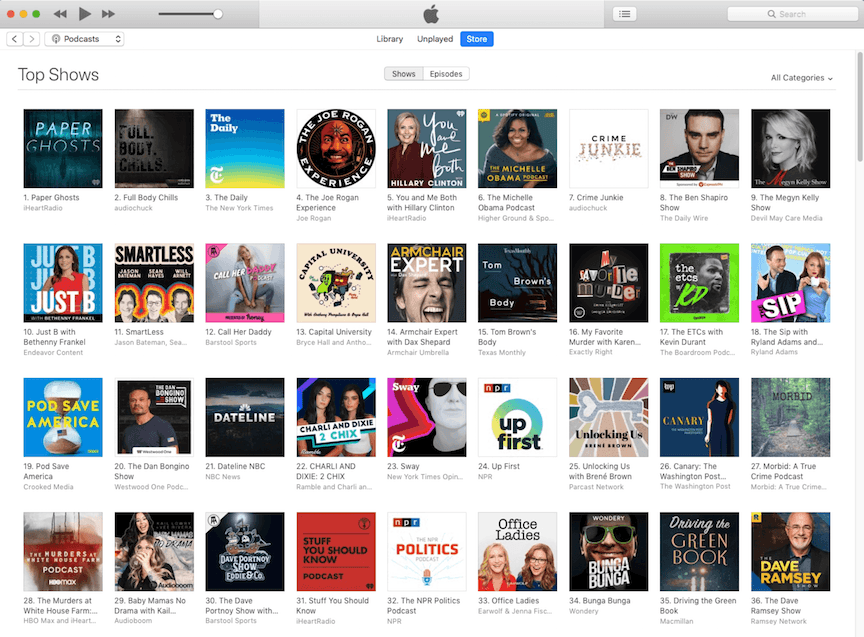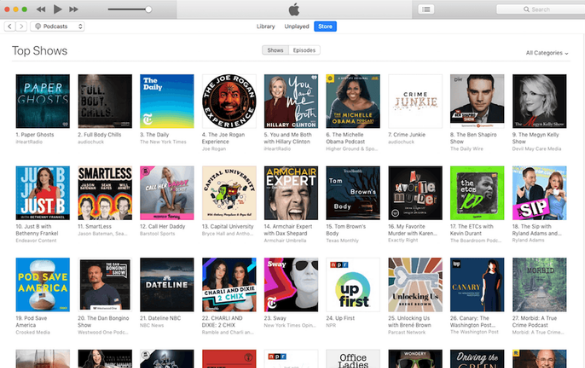-
 9 min. read
9 min. read
-
 Sarah Berry
Sarah Berry Web Marketing Consultant
Web Marketing Consultant
- Sarah Berry is a Google Analytics-certified Web Marketing Consultant at WebFX. She’s written over 400 articles on digital marketing, covering topics like SEO, CRO, and Amazon. When she isn’t polishing her Time Magazine Person of the Year Award, she’s spending time with her flock of ducks.
Want to expand your advertising strategy and reach a new and growing audience? Try podcast advertising 101! Podcasts are an increasingly popular medium.
As of February 2024, 62% of Americans had listened to a podcast, and 37% had listened to one within the last month.
Those percentages are up from 55% and 51% from the previous years, and the number of listeners continues to grow steadily. As podcasting grows, so does podcast advertising. Podcast ads are an excellent way to upgrade your digital advertising strategy.
According to a survey, 68% of listeners don’t mind podcast ads and sponsorships because they know they support the podcast.
Research from the Interactive Advertising Bureau (IAB) found that 61% of listeners had purchased a product or service they learned about on a podcast ad. But how does podcast advertising work? And how can you create an effective podcast advertising campaign?
We’ll answer these questions, give you podcast advertising best practices, and more in this guide. Welcome to podcast advertising 101.
Types of podcast ads
If you’re not familiar with podcast ads, take some time to listen to a few of the most popular podcasts. You’ll hear several different kinds of ads that typically appear at the beginning, in the middle, or at the end of an episode. Advertising on podcasts varies widely depending on the host(s).
They understand how to advertise on podcasts and usually put their own creative spin on the ad. How does podcast advertising work? The most common formats for podcast ads are:
- Baked-in ads: These ads are part of the podcast itself, and everyone who listens to the podcast will hear the same ads. These ads are typically read by the podcast host or an announcer. If the host reads the ad, they often have some freedom to adlib and deliver the ad in their own style.
If an announcer reads the ad, it’s likely more scripted and formal-sounding.
- Dynamically inserted ads: These ads are inserted into the podcast as the listener downloads or streams it. Different listeners will hear different ads. Rather than being read live, these ads are scripted and pre-recorded.
You also have several choices for when your ad will appear in the episode. The typical podcast ad options are:
- Pre-roll: These ads play at the beginning of the show, either before the show content or during the introduction.
- Mid-roll: These ads play at around the halfway mark of the show. They are typically longer than pre-roll and post-roll ads.
- Post-roll: These ads play at the end of the episode and are usually the least expensive type.
How podcast ad pricing works
Before starting a podcast advertising campaign, it’s important to understand podcast ad pricing. Let’s look at three podcast ad pricing models:
Cost per thousand impressions (CPM)
CPM stands for cost per mille, which is the cost per one thousand impressions, or listeners. The number of impressions may be calculated based on the number of times an episode is downloaded or the number of subscribers a podcast has.
CPM is by far the most common pricing model used for podcast advertising.
Cost per acquisition (CPA)
Another possible pricing model is CPA. Under this model, you pay a pre-determined amount for each new customer you acquire due to your advertisement. If, for example, you provided a unique promo code in your advertisement, you would pay each time someone used that promo code on your website.
Flat fee
Some podcast hosts charge a flat fee to advertise on their show, although this approach is relatively rare.

How to create a podcast advertising campaign
So, know that you’ve got some podcast advertising 101 knowledge, how do you create a successful podcast advertising campaign? We’re going to walk you through the essential steps and podcast advertising best practices. Keep in mind that you can complete these steps on your own, hire freelancers, or work with a podcast advertising agency.
If you work with a podcast advertising professional, you’ll have the additional cost of their services. However, you’ll get their expertise, which can help you avoid costly mistakes, and you’ll save time since they do the work for you. Here are six steps to creating an effective podcast advertising campaign.
1. Find the right podcast
One of the first and most important decisions you’ll have to make is which podcasts to advertise on. You have lots of options. According to Podcast Insights, as of April 2020, there were more than 1 million podcasts and 30 million podcast episodes.
When looking for podcasts, focus more on audience fit than the topic of the podcast. Find out about the demographics of the podcast listeners and see if they match the demographics of your ideal customers. While a show about your industry can be a good fit, your ideal audience probably listens to podcasts on a variety of topics.
Another factor to consider is the podcast’s release schedule. Many podcasts post a new episode every week, but others post monthly or at irregular intervals. Make sure the release schedule lines up with the timeline for your campaign.
You’ll also need to consider the pricing model each podcast uses and the likely costs of advertising on each show. Remember that, generally, the more listeners or subscribers a podcast has, the higher the CPM will be.
2. Choose the right ad types
Another major decision is the types of ads you want to run. The right ads for you depend on your goals and budget. Advertising on podcasts is a very different medium for promotion which is why it’s important to keep in mind the host’s tendencies when delivering a script.
Let’s take a look at each ad type and when you might want to use it.
- Baked-in, host-read ads: Baked-in ads feel more authentic than dynamically inserted ads, especially when a host reads them in their own style. Before choosing this option, make sure the host’s typical presentation style will work with your brand’s personality. In many cases, baked-in, host-read ads are an excellent option.
- Baked-in, announcer-read ads: This type of baked-in ad often appears in shows that have a more formal style. They are an excellent choice if you want the authenticity of baked-in ads but also want your ads to be more uniform.
- Dynamically inserted ads: If you have a time-sensitive offer, it might not make sense to place an ad that’s baked into a podcast episode forever. In this situation, dynamically inserted ads are a smart option since you can run them for a limited time. Dynamically inserted ads also make it easier to test several variations of your advertisement.
You’ll also need to think about when your ad should appear within the podcast episode.
- Pre-roll ads are great for getting listeners’ attention right away but are also easier to skip if they play before the show’s introduction. These ads are useful if you’re not sure listeners will stick around to listen to the whole episode.
- Mid-roll ads are typically longer than other ad types, so you can fit in more information. Listeners may also be less likely to skip these ads because they occur mid-episode. Due to their length, these ads may make more of an impression on listeners, especially if read by the show host.
- Post-roll ads are a budget-friendly option. Listeners may be more likely to skip these ads since the show’s main content is over by the time they hear your ad. However, if users listen to a whole episode or binge a series of episodes, post-roll ads can be a great way to reach listeners cost-effectively.
Looking at podcast ad examples can help you get an idea of what effective ads look like.
3. Strategize your spending
You’ll also need to determine your budget and create a strategy for your ad spend. To do this, consider your goals. Approximately how many impressions will it take to accomplish your goals?
This will give you an idea of an appropriate budget. For example, if your goal is to get 100 listeners to purchase your product, and your expected conversion rate for your ad is 3%, you’ll need to reach at least 3,334 listeners. Using the CPM for a given show, you can then calculate the cost of reaching those listeners.
4. Creating the ad
Of course, you also need to create your ad or hire someone to create it for you. If you’re creating a dynamically inserted ad, you’ll need to write a script and record the ad.
If creating a baked-in that the host or an announcer will read, you just need to write a script. You can create a script for the host or announcer to follow exactly.
If you want to give the host more freedom in how they present the ad, you can provide a bulleted list of talking points and note which information is essential to include.
5. Reach out and place your ads
Once you have developed your strategy, set your budget, and created your ad, you can start reaching out to podcasts and placing your ads. Depending on the show, you’ll talk to the show host themselves, a publisher, or a network representative. Many podcasters provide information about how advertisers can get in touch during their episodes, in their show notes, or on their websites.
You can also work with a podcast advertising agency that handles this part of the process for you.
Bonus Read: Top Podcast Ad Networks
6. Track your results
An essential part of running a podcast ad is tracking your campaign’s results. You can accomplish this in various ways:
- Vanity URLs: Vanity URLs are URLs that are unique to a podcast ad. In the ad, you tell listeners to go to this URL to, for instance, redeem an offer, browse your products, or read a piece of content. The number of visits to this URL tells you how many listeners followed your ad’s call to action.
- Promo codes: You can also create unique promo codes for each advertisement. Listeners can use this code at checkout on your website or in your store to get a discount or other offer.
- Surveys: You can survey new customers or visitors to your website and ask them how they heard about your company.
Putting your podcast advertising 101 knowledge to work
Well, that’s it — you’ve passed podcast advertising 101! Now, you understand how to advertise on podcasts and can get started on creating your first podcast advertising campaign.
Want to learn more about growing your business with digital advertising? Whether you’re into podcasting or blogging, we’ve got you covered.
Check out our free resources!
If you want a team of experts on your side when creating your first podcast advertising campaign, consider our podcast advertising services. Call us at 888-601-5259 or request a free quote to learn more.
-
 Sarah Berry is a Google Analytics-certified Web Marketing Consultant at WebFX. She’s written over 400 articles on digital marketing, covering topics like SEO, CRO, and Amazon. When she isn’t polishing her Time Magazine Person of the Year Award, she’s spending time with her flock of ducks.
Sarah Berry is a Google Analytics-certified Web Marketing Consultant at WebFX. She’s written over 400 articles on digital marketing, covering topics like SEO, CRO, and Amazon. When she isn’t polishing her Time Magazine Person of the Year Award, she’s spending time with her flock of ducks. -

WebFX is a full-service marketing agency with 1,100+ client reviews and a 4.9-star rating on Clutch! Find out how our expert team and revenue-accelerating tech can drive results for you! Learn more
Try our free Marketing Calculator
Craft a tailored online marketing strategy! Utilize our free Internet marketing calculator for a custom plan based on your location, reach, timeframe, and budget.
Plan Your Marketing Budget

Maximize Your Marketing ROI
Claim your free eBook packed with proven strategies to boost your marketing efforts.
Get the GuideTry our free Marketing Calculator
Craft a tailored online marketing strategy! Utilize our free Internet marketing calculator for a custom plan based on your location, reach, timeframe, and budget.
Plan Your Marketing Budget





